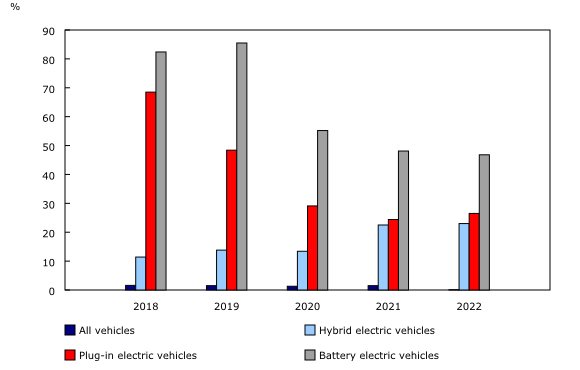Vehicle registrations, 2022
Released: 2023-11-02
26.3 million
2022
0.3% 
(annual change)
Highlights
The total number of road motor vehicles registered in Canada was 26.3 million in 2022, edging up 0.3% from 2021.
Light-duty vehicles accounted for 91.7% of total registrations in 2022, with multi-purpose vehicles surpassing passenger cars for the first time as the most common vehicle type in Canada.
Electric vehicles accounted for 3.0% of light-duty vehicle registrations in 2022, up from 2.3% in 2021.
Please visit the Light and medium-duty vehicle registrations: Interactive dashboard to interact with the data.
Slight increase in total registrations
The total number of road motor vehicles registered in Canada was 26.3 million in 2022, edging up 0.3% (or 78,655 units) from 2021. This was the smallest increase recorded in over 20 years, coinciding with a 7.9% decline in new motor vehicle sales in 2022 due in large part to the global semiconductor shortage.
Light-duty vehicles (LDVs), which include passenger cars, multi-purpose vehicles (MPVs), pickup trucks, and vans, continued to account for the majority (91.7%) of vehicles registered, up 0.1% from 2021 to reach 24.1 million vehicles in 2022.
Medium-duty vehicle registrations grew 4.0% from 2021 to 2022, with pickup trucks driving this growth. After reporting a decline in 2021, the number of bus registrations returned to 2020 levels in 2022. Finally, registrations of heavy-duty vehicles rose 2.0% in 2022 over the previous year.
Ontario had the highest number of total vehicle registrations in Canada in 2022, at 9.4 million vehicles (35.9%). However, the provincial total edged down 0.3% from 2021. In 2022, larger declines were observed in Alberta (-1.0%), Saskatchewan (-1.5%) and Prince Edward Island (-2.3%), while British Columbia saw total registrations increase by 2.9% compared with 2021.
Multi-purpose vehicles now on top
Looking at the LDV portion of the fleet, MPVs, which include sport utility vehicles and crossovers, grew 4.6% from 2021 to more than 9.2 million registrations in 2022, becoming the most common vehicle type registered in Canada. In 2017, 29.8% of LDVs were MPVs, but after five years of strong growth, MPVs accounted for 38.3% of registrations in 2022.
Conversely, passenger cars continued to lose relative share. In 2017, 45.0% of LDV registrations were passenger cars, but after a decline of 3.2% from 2021 to 2022, they represented 38.0% of LDV registrations in 2022.
The rising popularity of MPV over passenger car registrations in 2022 was seen across most of the country with the exceptions of Prince Edward Island, Nova Scotia, New Brunswick, and Quebec.
Registrations of light-duty pickup trucks, which have also been growing in recent years, took a pause in 2022, edging down 0.4% (-15,365 units) compared with 2021. Registrations of vans also dropped during the same period, down 3.8% to 1.7 million registered vehicles.
Discernible change by fuel type
After many years of steady growth, the number of registered LDVs using motor gasoline in 2022 edged down 0.6% from 2021. While 94.2% of all registrations remain motor gasoline, the share has edged down each year. The number of registered LDVs using diesel also decreased in 2022, down 0.9% compared with 2021.
Conversely, electric vehicles continued to grow in popularity and represented 3.0% of LDV registrations in 2022, up from 2.3% in 2021 and 1.8% in 2020. Among this fuel type, there were 372,696 hybrid electric vehicles (HEVs), 121,261 plug-in hybrid electric vehicles (PHEVs), and 224,175 battery electric vehicles (BEVs), with HEVs (+23.0%), PHEVs (+26.5%) and BEVs (+46.8%) all posting double-digit growth in 2022.
Zero-emission vehicles up across the country
One definition of zero-emission vehicles (ZEVs) includes only BEVs and PHEVs, both having the potential to operate without tailpipe emissions. With a federal government mandate that requires 100% of light-duty car and passenger truck sales to be zero-emission by 2035, all provinces and territories experienced growth in registered ZEVs during 2022. While 1.4% of Canada's registered LDVs in 2022 were ZEVs, two provinces continued to be out in front: British Columbia (2.8%) and Quebec (2.6%).
Note to readers
This annual release presents a count of registered vehicles based on administrative files provided by each province and territory. Registered vehicles include road motor vehicles, such as light road motor vehicles, medium-duty and heavy-duty vehicles, buses, motorcycles, and mopeds.
New Table 23-10-0308-01 replaces Table 23-10-0067-01 and caution should be used when comparing data from each.
Gross Vehicle Weight Rating (GVWR): the maximum weight a vehicle is designed to carry. Manufacturers set the GVWR.
Light-duty vehicles refer to vehicles with a GVWR less than 4,535 kilograms and includes GVWR classes 1 and 2.
Medium-duty vehicles refer to vehicles with a GVWR between 4,536 kilograms to 11,793 kilograms and includes GVWR classes 3, 4, 5 and 6.
Heavy-duty vehicles refer to vehicles with a GVWR equal to or greater than 11,794 kilograms and includes GVWR classes 7 and 8.
Battery electric vehicles (BEVs) are vehicles powered solely by a rechargeable battery pack and produce zero tailpipe emissions.
Plug-in hybrid electric vehicles (PHEVs) are vehicles with a rechargeable battery pack and an internal combustion engine. They run on electric power until the battery is drained and then the internal combustion engine takes over for propulsion.
Zero-emission vehicles are BEVs or PHEVs that have the potential to produce no tailpipe emissions.
Hybrid electric vehicles are vehicles with a rechargeable battery pack, which provides an extra boost of power, in addition to having an internal combustion engine. They are not considered part of zero-emission vehicles.
The Transportation Data and Information Hub—a web portal developed jointly by Statistics Canada and Transport Canada—provides Canadians with online access to comprehensive statistics and measures on the country's transportation sector.
Contact information
For more information, or to enquire about the concepts, methods or data quality of this release, contact us (toll-free 1-800-263-1136; 514-283-8300; infostats@statcan.gc.ca) or Media Relations (statcan.mediahotline-ligneinfomedias.statcan@statcan.gc.ca).
- Date modified:


